Ciabatta Bread
This easy ciabatta bread recipe results in beautiful rustic loaves of classic Italian bread, with its perfectly chewy interior texture studded with those wonderfully large air bubbles. It’s practically begging to be dipped into your favorite soup or stew.

I have such a love affair with baking homemade bread; the smell of yeast and fresh, rising dough has such a calming effect.
It makes me want to curl up on a covered wrap-around porch and read during a rainstorm.
Why You’re Going to Love It
I've long loved ciabatta bread for its chewy exterior and soft crumb speckled with air holes. It's the perfect bread for dunking into soup, slicing horizontally and making a sandwich, converting to garlic bread, or for simply slathering with butter and eating until your heart's content.
This recipe is not complicated, although it does take a little bit of planning ahead. Actual hands-on time is less than an hour in total, and the dough is very forgiving. Let’s dive into the details of the recipe!
Ingredients Overview
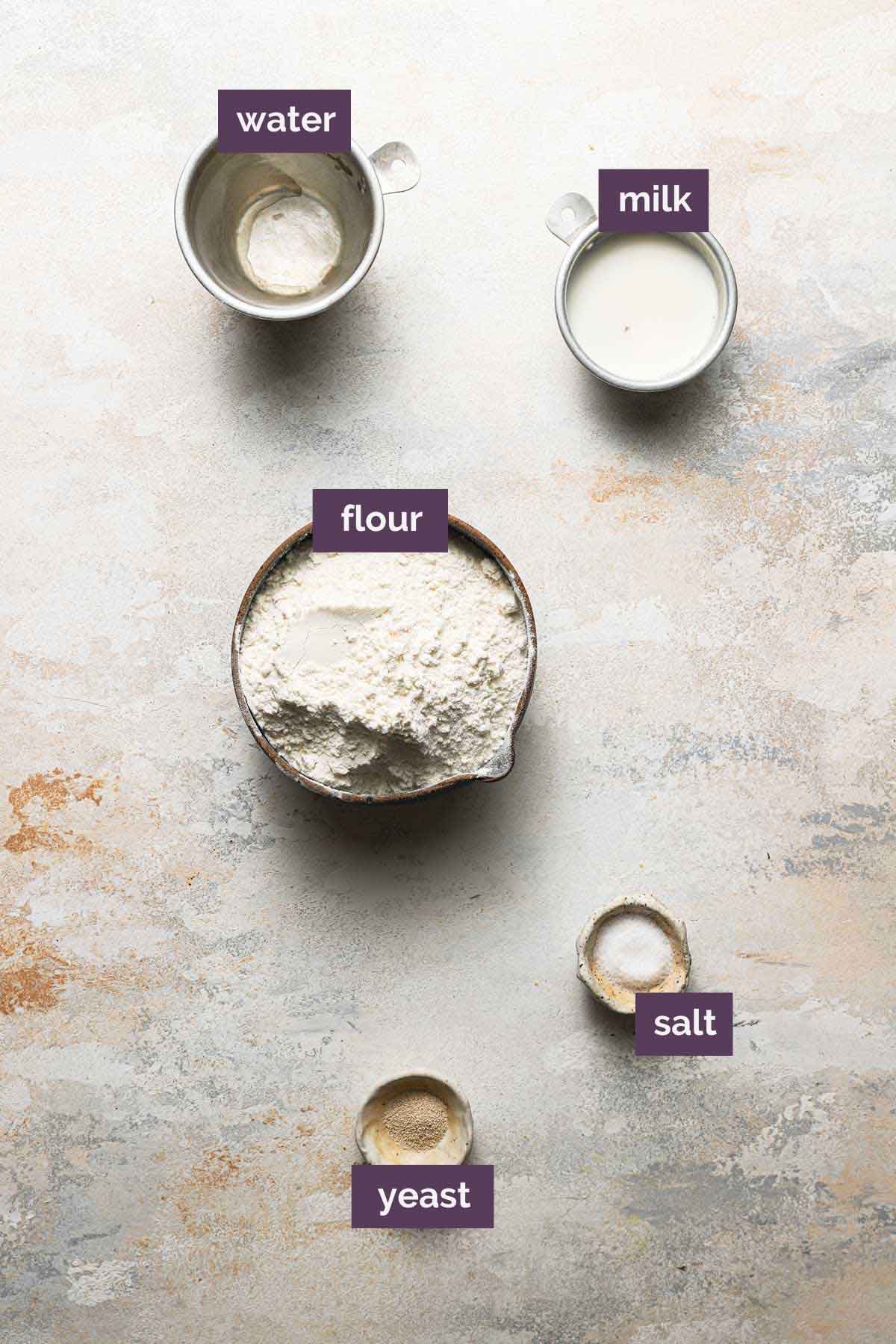
The beauty of this bread is its incredibly simplistic and rustic nature. Below is a quick overview of the ingredients we use with some notes on them and substitutions you may be wondering about:
- Flour – For this recipe, we use all-purpose flour. It has the perfect amount of protein to produce a ciabatta with a perfect rise and airy texture. Substituting bread flour will result in a denser, chewier, and less airy loaf of bread.
- Yeast – We use instant yeast, which is easily mixed into dry ingredients. If you need to substitute active dry yeast, be aware that you will need to activate it in both the sponge and the dough by first ensuring that the water is warm (100 to 110 degrees F), sprinkling the yeast over the water, giving it a quick stir, and then waiting 10 or 15 minutes, until it becomes foamy. At that point, proceed with the rest of the recipe.
- Water – A vital component! Ciabatta dough is considered a high-hydration dough because of the ratio of water to flour. For this reason, you will notice that it is rather sticky and a very wet dough. We’ll talk below about how best to handle the dough.
- Salt – Not only does this help to balance flavors in bread, but it also aids in coloring the crust, controlling the rise, and developing gluten. Don’t leave it out!
- Milk – A protein in milk helps to control the size of the air bubbles in the bread. Without it, the holes are larger, which doesn’t leave as much bread structure. The best milk is whole or 2%, but 1% can also be used in a pinch. You can also substitute 2 tablespoons of nonfat milk powder (increase the water in the dough step to 1 cup).
Ciabatta Dough: Two Parts
The dough for ciabatta bread is made in two stages:
- Sponge (or Biga) – This first mixture is prepared the day before you plan to bake the bread. It is comprised of just flour, yeast, and water. This fermented sponge is what gives the ciabatta its amazing, slightly tangy flavor.
- Dough – The next day, you will mix together the dough, which will include the sponge that has been sitting overnight.
How to Make the Dough
Let’s walk through how the dough comes together:
Step #1: Make the Sponge – You’ll mix together the flour, yeast, and water with a wooden spoon, cover the bowl with plastic wrap, and let sit overnight or for up to 24 hours.
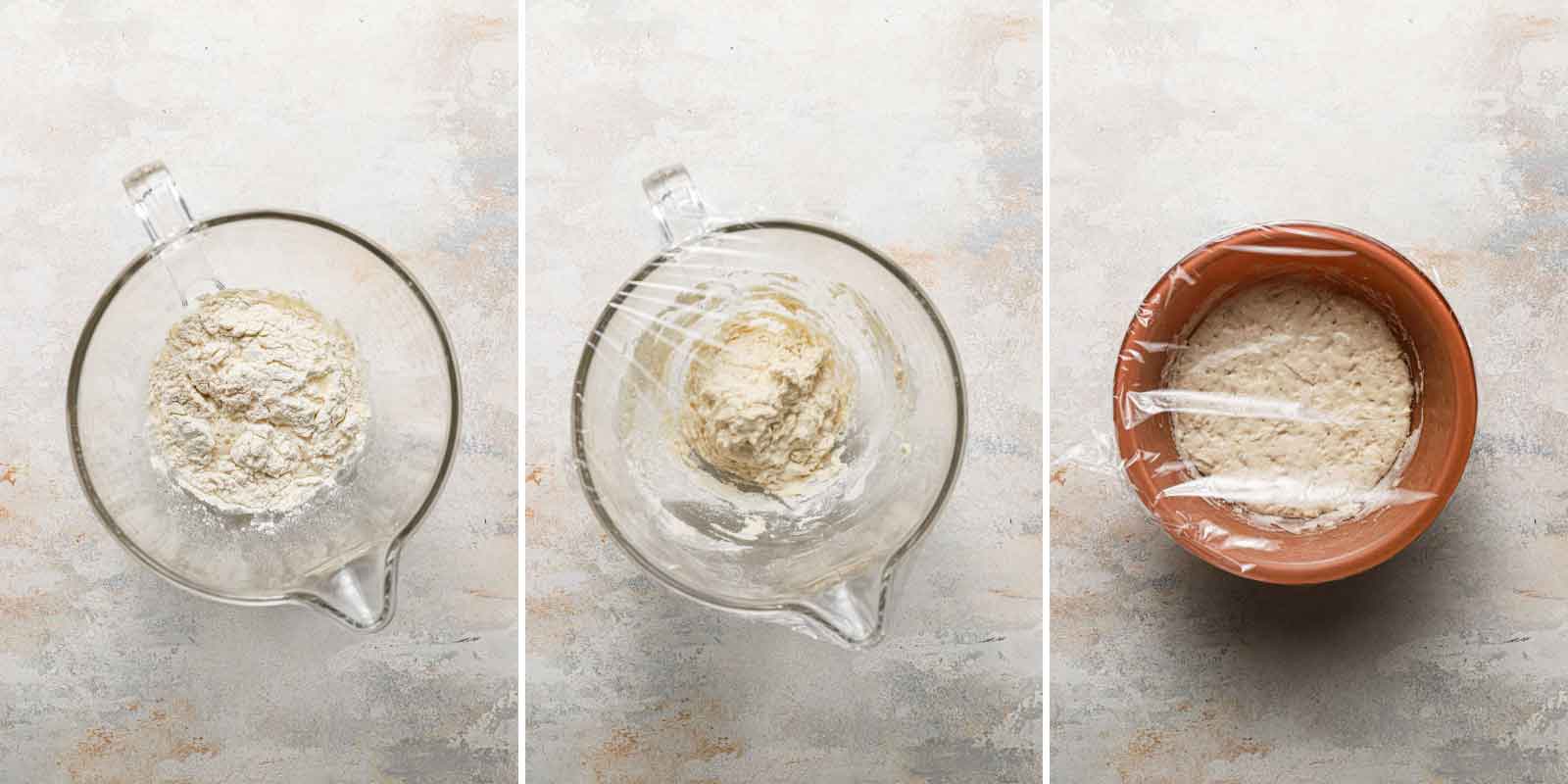
Step #2: Mix the Dough – Add the sponge and all of the dough ingredients to a stand mixer and mix with the paddle attachment until it becomes a uniform mass and pulls away from the sides of the bowl. Switch to the dough hook and knead until the dough is shiny and smooth (about 10 minutes).
Step #3: Rise – Transfer the dough to a bowl, cover with plastic wrap, and set at room temperature until doubled in size (about 1 hour).


Folding the Dough
This folding process may seem tedious, but it is an integral part of achieving those picture-perfect air bubbles! Here is how you do it:
Make sure your spatula or bowl scraper is sprayed with cooking spray (or rub it with olive oil).
Then lift the end of the dough over itself toward the middle, rotate the bowl 90 degrees, repeat, and then six more times, for a total of 8 times.
Save This Recipe
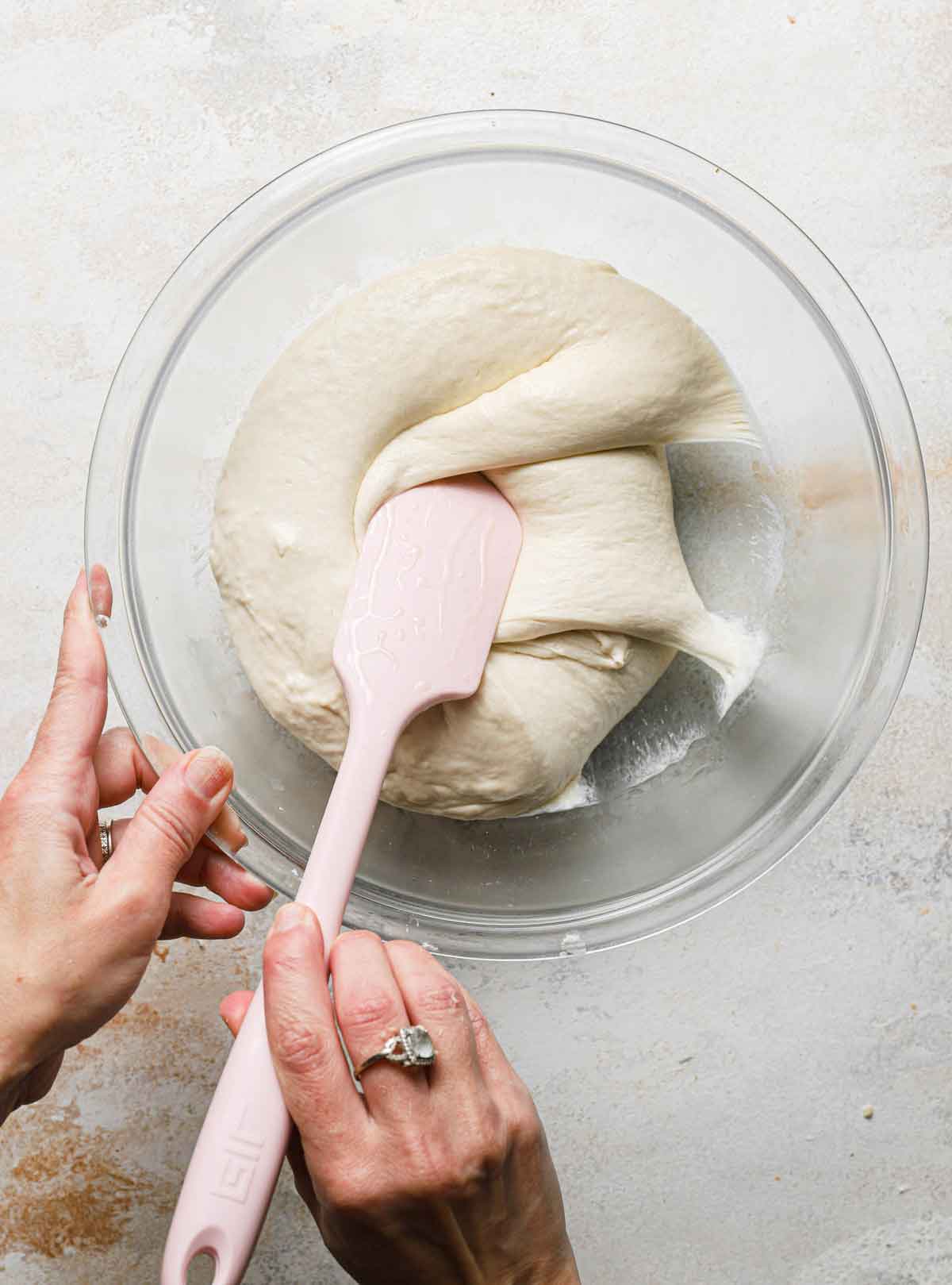
Cover the bowl with plastic wrap, let rest/rise for 30 minutes, then repeat the exact same folding process again.
Once done, cover the dough once more and allow to double in size before proceeding with shaping.
Shaping the Ciabatta
The final shaping of the ciabatta before baking is what gives the bread its characteristic “slipper” shape, from which its name originates (“ciabatta” means slipper in Italian; the bread was given this name because its shape resembles a well-worn slipper).
Shaping Step #1: Turn the dough out onto a floured surface gently (so it does not completely deflate), dust it with flour, and divide in half with a bench scraper.
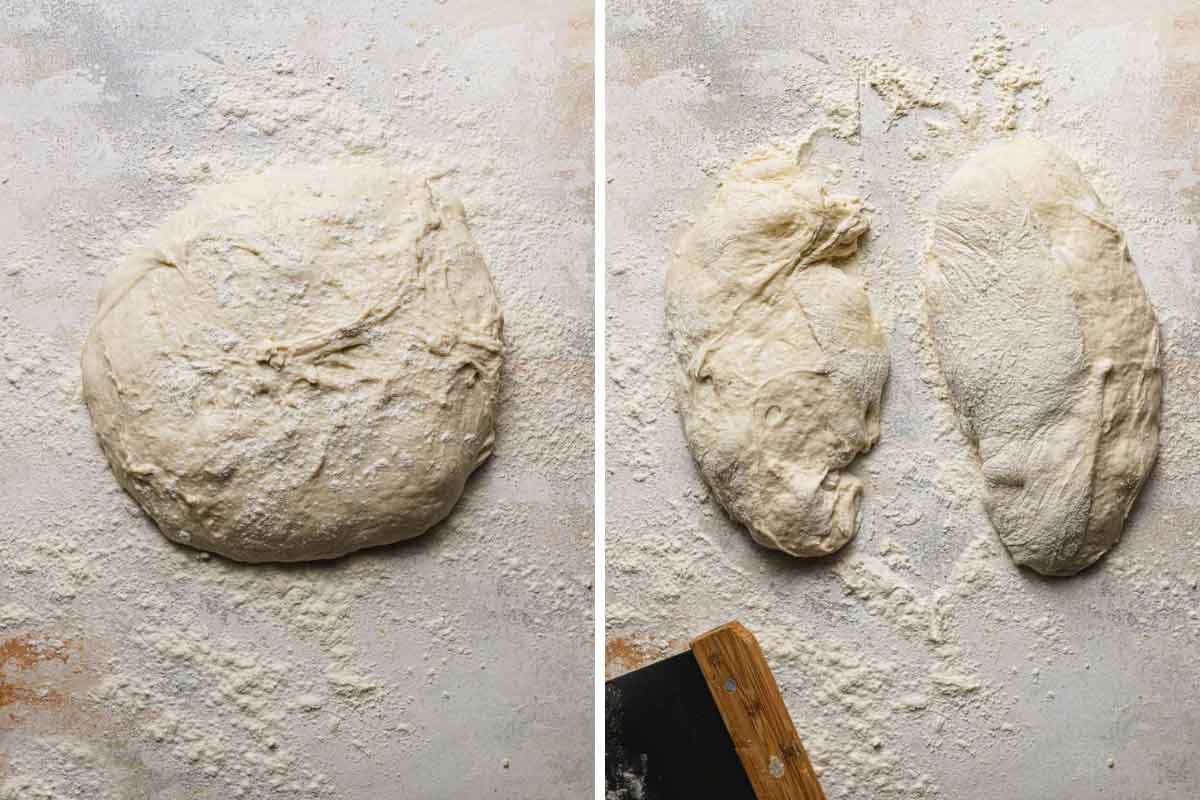
Shaping Step #2: Place one piece of dough cut-side-up and dust with flour, then using fingertips, gently press the dough into a 12×6-inch rectangle. Fold one end of the dough towards the middle, and fold the other end over the top of the first fold (as you would fold a letter in thirds). Repeat with the second loaf of dough.
Shaping Step #3: Transfer each loaf to a rectangular piece of parchment that has been dusted with flour. Dust the tops of the loaves with flour, cover with plastic wrap, and allow to sit for 30 minutes.
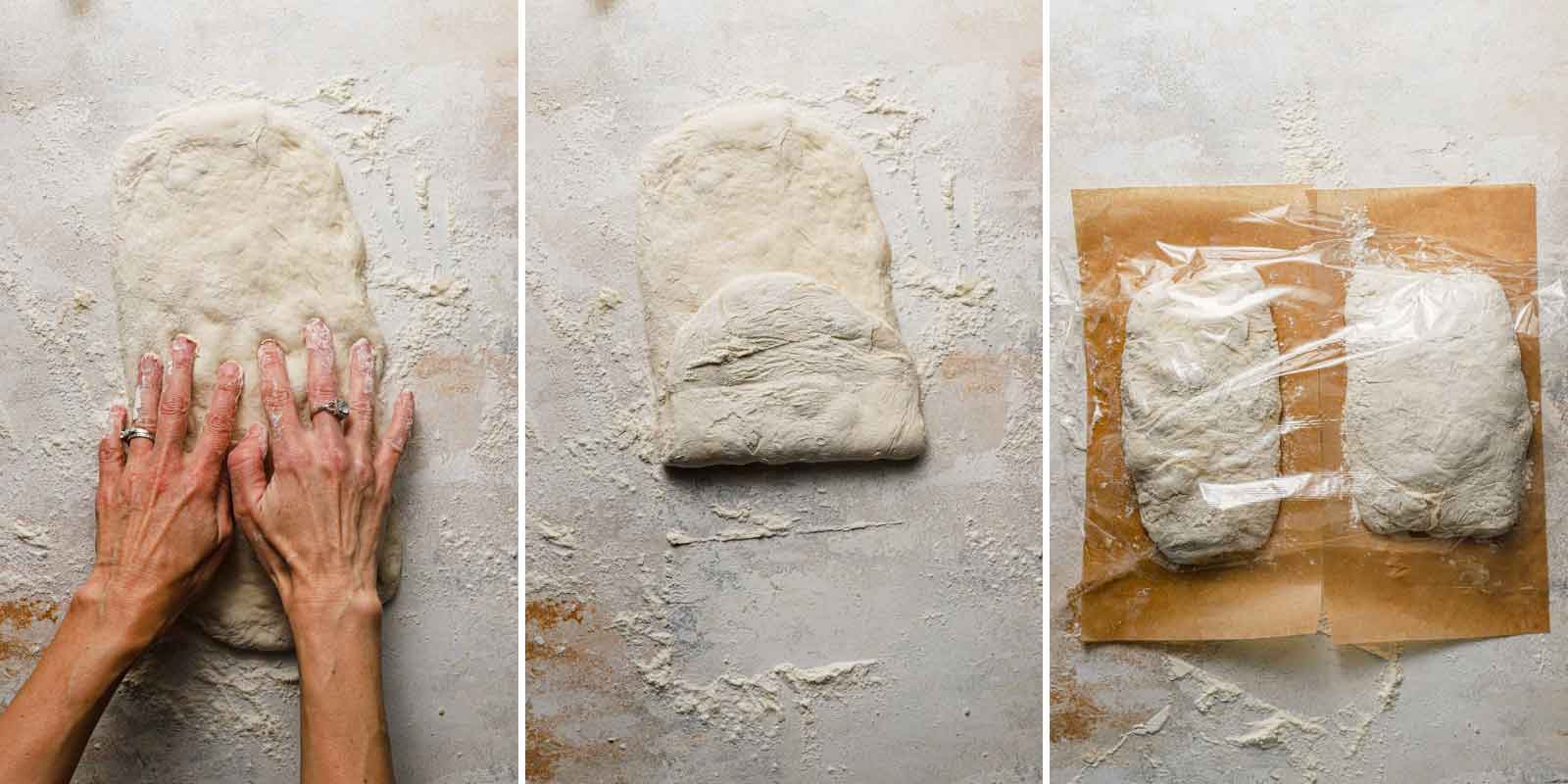
Baking the Bread
When the 30 minutes is up, you will slide the parchment pieces with the loaves onto a pizza peel. Use floured fingertips to poke the surface all over to create a 10×6-inch rectangle. Lightly spritz the loaves with water and slide the loaves onto a preheated pizza stone in the oven (you can also use an inverted baking pan, see notes below).
Spray with water twice more during the first 5 minutes of baking, then continue baking until the internal temperature registers 210 degrees F.
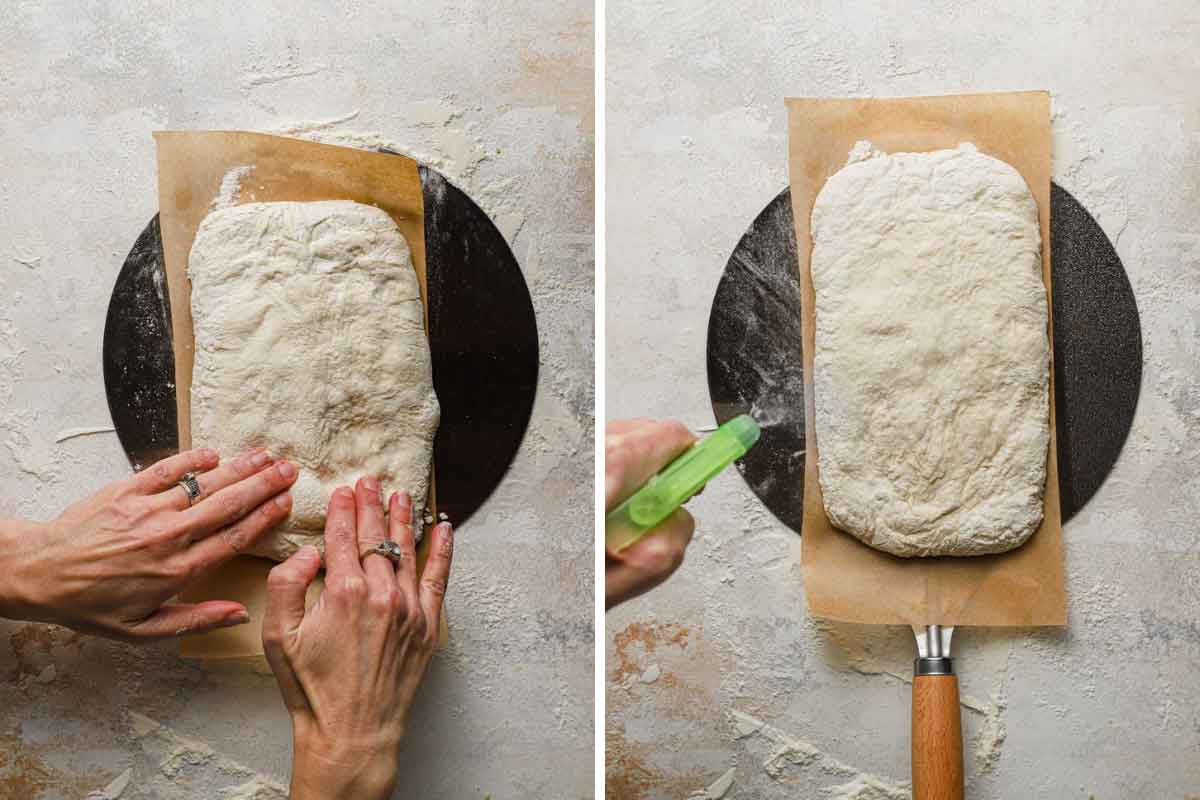
Recipe Notes and FAQ
A few notes and the answers the some commonly asked questions:
- Equipment – To make the most of this recipe, I recommend using the following pieces of equipment: stand mixer / bowl scraper / bench scraper / baking stone / parchment paper / pizza peel / spray bottle / digital instant-read thermometer / wire cooling rack
- Yeast – If you substitute active yeast instead of instant yeast, you will need to be sure to activate it in warm water first, instead of simply mixing it with the flour and room temperature water.
- Milk – Whole milk is preferred, but 2% or 1% can also be used. You can also substitute 2 tablespoons of nonfat milk powder (increase water in dough to 1 cup).
- Stand Mixer – Due to the high hydration of this dough and how sticky it is, a stand mixer is important for being able to manage the dough properly.
- Handling the Dough – Keep in mind that this dough is very wet and sticky; the key to working it well is to do so quickly and gently. Too much heavy-handling of the dough will result in flat, tough loaves. Use a bowl scraper when possible and if you need to use your hands, make sure they are well-floured.
- Baking Stone – If you do not have a baking stone, you can use a baking sheet that is turned upside on the lowest oven rack and preheated as directed.
- Making Ciabatta Rolls – To make rolls, use a bench scrape to divide each loaf into 6 or 8 even-sized portions. Separate them a bit on the parchment sheet so they aren’t touching.
- Storage – The bread can be kept at room temperature, wrapped in foil, for up to 2 days.
- To Reheat the Bread – Keep it wrapped in foil and place in a 450-degree oven for 6 to 8 minutes.
- Freezing the Bread – Wrap tightly in foil, then place in a ziploc freezer bag and freeze for up to 3 months. Thaw at room temperature, then warm and re-crisp the crust using the reheating method above.

More Popular Homemade Bread Recipes
- The Best White Bread Recipe
- Grandma’s Banana Nut Bread
- Copycat Pizza Hut Breadsticks
- Classic Italian Bread Recipe
- Spicy Cheese Bread
Watch How to Make Homemade Ciabatta Bread:
If you make this ciabatta bread recipe and love it, remember to stop back and give it a 5-star rating - it helps others find the recipe! ❤️️

Ciabatta Bread
Ingredients
For the Sponge:
- 1 cup (130 g) all-purpose flour
- ⅛ teaspoon instant yeast
- ½ cup (120 ml) water, at room temperature
For the Dough:
- 2 cups (260 g) all-purpose flour
- 1½ teaspoons salt
- ½ teaspoon instant yeast
- ¾ cup (180 ml) water, at room temperature
- ¼ cup (60 ml) whole or 2% milk, at room temperature
Instructions
- Make the Sponge: Combine the 1 cup flour, ⅛ teaspoon yeast, and ½ cup water in a medium bowl and stir with a wooden spoon until a uniform mass forms. Cover the bowl tightly with plastic wrap and let stand at room temperature for at least 8 hours or up to 24 hours.
- Make the Dough: Place the sponge and the dough ingredients (flour, salt, yeast, water and milk) in the bowl of a stand mixer fitted with the paddle attachment. Mix on low speed until combined and a shaggy dough forms, about 1 minute, scraping down the bowl and paddle as needed. Increase the speed to medium-low and continue mixing until the dough becomes a uniform mass that collects on the paddle and pulls away from the sides of the bowl, 4 to 6 minutes.
- Change to the dough hook and knead the bread on medium speed until smooth and shiny (the dough will be very sticky), about 10 minutes.
- Transfer the dough to a large bowl, cover tightly with plastic wrap, and let rise at room temperature until doubled in size, about 1 hour.
- Spray a rubber spatula or bowl scraper with non-stick cooking spray. Fold the dough over itself by gently lifting and folding the edge of the dough toward the middle. Turn the bowl 90 degrees, and fold again. Turn the bowl and fold the dough 6 more times (for a total of 8 times).
- Cover with plastic wrap and let rise for 30 minutes.
- Repeat the folding as in step #7, replace the plastic wrap, and let rise until doubled in size, about 30 minutes.
- One hour before baking, adjust an oven rack to the lower-middle position, place a baking stone on the rack and preheat the oven to 450 degrees F.
- Cut two 12×6-inch pieces of parchment paper and dust liberally with flour. Transfer the dough to a floured work surface, being careful not to deflate it completely. Liberally flour the top of the dough and divide it in half with a bench scraper. Turn 1 piece of dough cut-side-up and dust with flour. With well-floured hands, press the dough into a rough 12×6-inch rectangle. Fold the shorter sides of the dough toward center, overlapping them like you would fold a letter in thirds, to form a 7×4-inch rectangle. Repeat with the second piece of dough.
- Gently transfer each loaf, seam-side-down, to the parchment sheets, dust with flour, and cover with plastic wrap. Let the loaves sit at room temperature for 30 minutes (the surface of the loaves will develop small bubbles).
- Slide the parchment pieces with the loaves onto a pizza peel. Using floured fingertips, evenly poke the entire surface of each loaf to form a 10×6-inch rectangle; spray the loaves lightly with water. Slides the loaves and parchment onto the baking stone. Bake, spraying the loaves with water twice more during the first 5 minutes of baking time, until the crust is deep golden brown and the loaves register 210 degrees F, 22 to 27 minutes.
- Transfer the loaves to a wire rack, discard the parchment, and let cool to room temperature for at least 1 hour before slicing and serving. The bread can be wrapped in a double layer of plastic wrap and stored at room temperature for up to 3 days. Wrapped with an additional layer of foil, the bread can be frozen for up to 1 month. To recrisp the crust, thaw the bread at room temperature (if frozen), and place unwrapped bread in 450-degree oven for 6 to 8 minutes.
Notes
- Equipment - To make the most of this recipe, I recommend using the following pieces of equipment: stand mixer / bowl scraper / bench scraper / baking stone / parchment paper / pizza peel / spray bottle / digital instant-read thermometer / wire cooling rack
- Yeast - If you substitute active yeast instead of instant yeast, you will need to be sure to activate it in warm water first, instead of simply mixing it with the flour and room temperature water.
- Milk - Whole milk is preferred, but 2% or 1% can also be used. You can also substitute 2 tablespoons of nonfat milk powder (increase water in dough to 1 cup).
- Stand Mixer - Due to the high hydration of this dough and how sticky it is, a stand mixer is important for being able to manage the dough properly.
- Handling the Dough - Keep in mind that this dough is very wet and sticky; the key to working it well is to do so quickly and gently. Too much heavy-handling of the dough will result in flat, tough loaves. Use a bowl scraper when possible and if you need to use your hands, make sure they are well-floured.
- Baking Stone - If you do not have a baking stone, you can use a baking sheet that is turned upside on the lowest oven rack and preheated as directed.
- Making Ciabatta Rolls - To make rolls, use a bench scrape to divide each loaf into 6 or 8 even-sized portions. Separate them a bit on the parchment sheet so they aren't touching.
- Storage - The bread can be kept at room temperature, wrapped in foil, for up to 2 days.
- To Reheat the Bread - Keep it wrapped in foil and place in a 450-degree oven for 6 to 8 minutes.
- Freezing the Bread - Wrap tightly in foil, then place in a ziploc freezer bag and freeze for up to 3 months. Thaw at room temperature, then warm and re-crisp the crust using the reheating method above.
- Recipe from Baking Illustrated
Did you make this recipe?
Leave a review below, then snap a picture and tag @thebrowneyedbaker on Instagram so I can see it!
This recipe was originally published in March 2014.
Photography by Dee Frances.


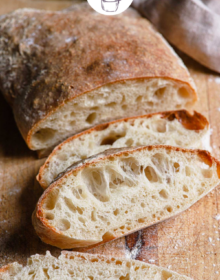



I found your recipe a few years ago and have had success every single time using a pizza stone/ standard fan forced kitchen oven. Always a winner. Unfortunately I lost the recipe and could not find for the last 18 Months and i must say no other Ciabatta receipt stacks up. Great news though have just found your marvellous recipe again and my wood fired pizza oven arrives this week and 8 can’t wait to try it again. Some notes on why some of the commenters baking may not of worked. Bread baking is finicky and it is a good idea to sift flour first as a “packed” cup of flour is different to a sifted cup of flour especially dependent on where you live and what season it is. I live in Far North Queensland, Australia and we have high temps and high humidity so it can make a huge difference on quantities required. The dough must be “wet” with very minimal to no kneading. The less you handle the dough the better. The sponge is best o/night or even 24hrs. Again, watch the quantities of additional flour and don’t be too heavy handed as this Cam make your loaf heavy and dense the opposite of what a good Ciabatta should be. Using a spray bottle to form a great crust is also a must and “00” bread/pizza flour can be substituted for AP flour without detriment to the end result. The key I have found again is to resist the temptation to work the dough, just let it do its thing and hopefully you will be delighted with your finished loaf/s. Thanks Michelle for a great recipe and I will update once we have cooked our first loaves in our new Pizza Oven!
I made this bread tonight and it was PHENOMENAL. I made the sponge and it actually sat on my counter for a little more than 24 hours. Maybe 27. When I started with the sponge it seemed a little too thick, not enough liquid, so I did add more water. Probably due to measuring ingredients wrong the first time.
The smell filled the entire house!!!! There is nothing like the smell of fresh baked bread. The dough was pretty sticky and seemed fragile, but everything came together perfectly. I will try and take a picture of the second loaf before it gets devoured, the first one went like a Krispy Kreme Donut under the “HotLight” This is definitely my go to bread recipe now!!! I don’t even know if I’ll ever try another recipe again. Sandwiches, paninis, burgers, you name it….or just by itself with butter or garlic/olive oil!
Thank you Michelle!!
Hi Colleen, So awesome to hear you loved the bread! Thanks so much for taking the time to stop back and leave a review!
The best recipe for ciabatta and I aslo tried it as pizza dough, the success was a wonderfull pizza, oven on crispy pizza mode at 550 F and baking stone preheated.
I don’t have a spray bottle on hand. What would you recommend?
You can put a pan of hot water on the bottom rack and leave it there so it steams in the oven.
I didn’t have one either. I ended up wetting my hands under the sink and flicking the water on.
This is the best aan easy recipe for ciabatta bread taste delicious. Thank you for the recipe Will print and make every saturday ..
We’re did you get your scraper. Love that bread ha ha ha.
Hi Jules, This is the scraper, I love it!! >> http://amzn.to/2vu7oYf
I made this bread over the weekend. It is DELICIOUS! I found that when I did the initial mix with the paddle attachment, it never really came together. Do you think this is because of the humidity in my area? Thanks!
Hi Amy, It definitely could be; you could try sprinkling in just a bit more flour, but as you can see from the other photos, it’s a really slack/soft/loose dough.
Fabulous recipe! Went to bed at 1 AM but it was worth it. All day everyone has been raving about this bread.
HRB
Thank you for this post – love your blog! Instead of shaping the loaves, could I bake as a boule in a dutch oven (like NYT no-knead)? TIA!!!
Hi Leah, I’ve never attempted it and I’m not sure how it would turn out (I’ve never seen a ciabatta boule!). If you try it, let me know!
If I don’t have a stand mixer, can I make this bread by just lots of kneading? I have baked bread for 45 years, but never used a mixer. I do have a hand-mixer, but that just has small beaters.
Hi Anne, You could, I would just caution to try not to use too much extra flour, as the dough will be sticky.
I tried this last weekend, it was excellent!
Made an attempt at your recipe yesterday/today. My dough didn’t look at tacky as yours, although it rose nicely, with the exception of the “loaf rise”. Baked nicely, although it didn’t have the bubbles inside, but it was still super yummy. Thinking my house was too chilly, but not sure…
I woulduld have to make this by hand as I do not have a mixer. Also would it be possible for you to give quantities in lb and oz as I do not have cups and don’t know how much a cup full would weigh. Many thanks
Hi Irene, I think theoretically you could make it by hand, but it’s a pretty wet dough. I use 1 cup = 5 ounces for my flour measurements, that should help!
Made yesterday and WOW! The ciabatta recipe I had used in the past was basically the same as far as ingredients but the process was a little different (it didn’t have the “folding” during the rise). I make sandwich buns, just “pour” the dough on a well floured board, use a bench scraper or sharp knife to cut into sandwich size, sorta square buns, gently transfer each one to parchment lined baking sheets, let rise, mist lightly with water, pop into the oven for about 20 minutes, rotating the baking sheet halfway thru the cooking time. Best sandwich buns ever!
In this ciabtta bread recipe do you need a large bowl because it won’t seal completely with one wrap in a large bowl and it is hard to wrap tightly I think it needs two wraps
Thank you for making the directions clear. I made the sponge last night and will be making the Ciabatta bread today for horderves on Thanksgiving (in two days). I am sure it will be wonderful and fill the house with warmth. I’ll return with my guest review. Until then Happy Thanksgiving and sharing your recipe. Patti
Ok I made this bread today just like I said and have a few tips not included. 1) Paddle time is off and I ended up needing to add more flour to get it pull away from the mixer bowl.
2) Rising time took much longer on the first stage.
However, all in all this is a wonderful recipe and not to hard. 5 minutes to go on the bread in the over and it looks great. Tomorrow we will have the reviews.
Wow, ein richtig tolles Rezept für ein Ciabatta Brot. Da bekommt man Appetit und vor allem ist es sehr leicht zum nachmachen.
Liebe Grüße vom Kuchenbäcker
I made this two ways. One in bread machine and one as instructed. Both times my dough was too loose to form a ball after first combining. Is it okay to add extra flour just to the point of forming the ball? Have you found you needed to do this as well? Thanks! Original method looks much better ?Have yet to taste them.
Thanks
Carol
What should the sponge look like after 12-15 hours? Should it have changed at all from the night before, because mine looks exactly the same as when I first made it and I don’t know if I should continue with the rest of the bread or just start over. Thanks!
Hi Kelly, It won’t look drastically different, you should be fine!
This recipe is amazing the Instructions were so easy to follow the bread turned out perfect
We had tried making bread so many times only to be disappointed with the result, that we gave up on bread-making. This recipe has turned us around. It was hands-down the best bread we have ever tasted! We will be making this again and again. Thank you so much for sharing this recipe and method. :-)
I realize that this dough is supposed to be wet, but mine turned out liquid when I followed the recipe. I ended up using two more cups of flour and the loaves turned out beautifully. I was suprised that no one else commented on this. I guess I am weirdo.
Made the bread today, came out great, Thank you so much for sharing! ( I used active dry yeast, bread flour because I have them. )
Hi! I dont have a pizza peel and a baking stone. What can I use as a substitute? Thanks in advance
Hi Lea, In place of the baking stone you can use a baking sheet (just know that the bottoms may not be as crisp), and for the peel you could use parchment on an upside-down baking sheet or cookie sheet. You basically want something that will help you slide the loaves onto the pan in the oven.
The most successful ciabatta I’ve tried. Most recipes turned out dense with small bubbles. I’ve tried this recipe with all purpose and tipo 00. Both turned out great with large holes! Thank you for sharing the recipe!
This recipe did not work for me. I do not have a stand mixer so I tried to use the stretch and fold method, with resting in between. This dough was extremely wet and would not do anything. They hydration level for this particular recipe is very high for ciabatta, 94%. This is assuming 125 g per cup of flour. Most ciabatta recipes use 81%. I am curious to know how you measured your flour? I am going to try a different recipe because this just did not work. disappointed.
Have you ever tried it with bread flour?
Hi Erin, I haven’t!
Very good…will make again
At first I thought, “what a lot of trouble to go to for bread” but following the steps wasn’t as difficult as I first thought and it was WELL worth it! I don’t have a baking stone so I just used a very heavy duty cookie sheet and the bread came out perfecto!
I accidentally doubled the sponge…can I freeze the raw dough once I make the ciabatta dough tomorrow? Before the 30 minute rise time maybe?
Hi Cori, I have not tried freezing the dough, I have no idea how it would respond once you thaw it.